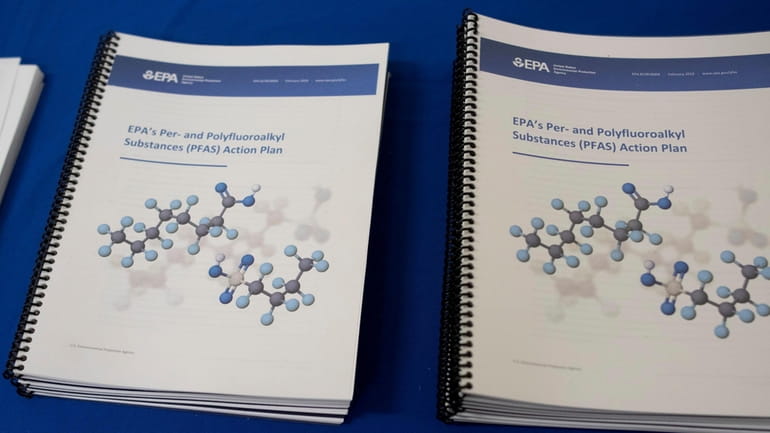EPA limits on PFAS boost clean water fight on Long Island

Copies of the U.S. Environmental Protection Agency's Per- and Polyfluoroalkyl Substances Action Plan on a table at EPA Region 2 headquarters in Manhattan. Credit: Charles Eckert
It took too long, but the federal Environmental Protection Agency finally did the right thing last week in announcing regulations requiring water providers to remove two toxic chemicals from drinking water.
PFOS and PFOA belong to a class of chemicals known as PFAS. Their full names are unpronounceable, but their nickname is ominous. They're called "forever chemicals" because they do not break down. They seep into soil and water, and have been linked to cancer, liver disease, asthma, damage to the immune and cardiovascular systems, low birthweight, and fertility and thyroid problems. And they are everywhere, in stain-resistant fabrics, firefighting foam, waterproof clothing, nonstick cookware, dental floss, and toilet paper. Now there are claims they are in our food, too. A 2020 study found that the tap water of up to 200 million Americans contains PFAS.
Scientists say the ubiquity of these chemicals in modern life has transferred to humans: PFAS can be found in the blood of nearly every American, including newborns.
Clearly, action was warranted. The EPA reduced its previous generic limit of 70 parts per trillion to 4 parts per trillion, the threshold of reliable detection. That's good for human health. But water providers, including those on Long Island, are expressing concerns about the high cost of complying with the new rules. That's understandable. Treating water is expensive. But treating cancer is more so.
In 2020, New York set drinking water standards at 10 parts per trillion for PFAS, found in hundreds of public and private wells on the Island. Some local water districts have been installing the carbon filtration systems needed to filter out PFAS, systems that can cost $1.5 million per well — and more if the new rule drives carbon prices higher. The state has helped with funding and must continue to do so.
In her executive budget, Gov. Kathy Hochul proposed putting another $500 million into the clean water infrastructure fund that has provided grants for water districts; the State Senate and Assembly budgets each pitched $600 million. The EPA ruling makes that funding urgent. There also is money in the state environmental bond act approved by voters last year, and in a $9 billion package Congress approved for the EPA last year for water infrastructure. Additionally, water suppliers should continue to sue companies like Dow Chemical to recover treatment costs. Still, ratepayers might have to bear part of the burden. That would be unfortunate but necessary when the goal is protecting human health.
After comments and hearings, the new EPA limits are expected to become final by year's end. The state will be bound by those but it can act more quickly to align its standards now — and to set drinking water limits on 23 other PFAS chemicals. After all, the EPA says the goal should be zero exposure to chemicals in this class.
It's a costly fight, but one that must be waged.
MEMBERS OF THE EDITORIAL BOARD are experienced journalists who offer reasoned opinions, based on facts, to encourage informed debate about the issues facing our community.
